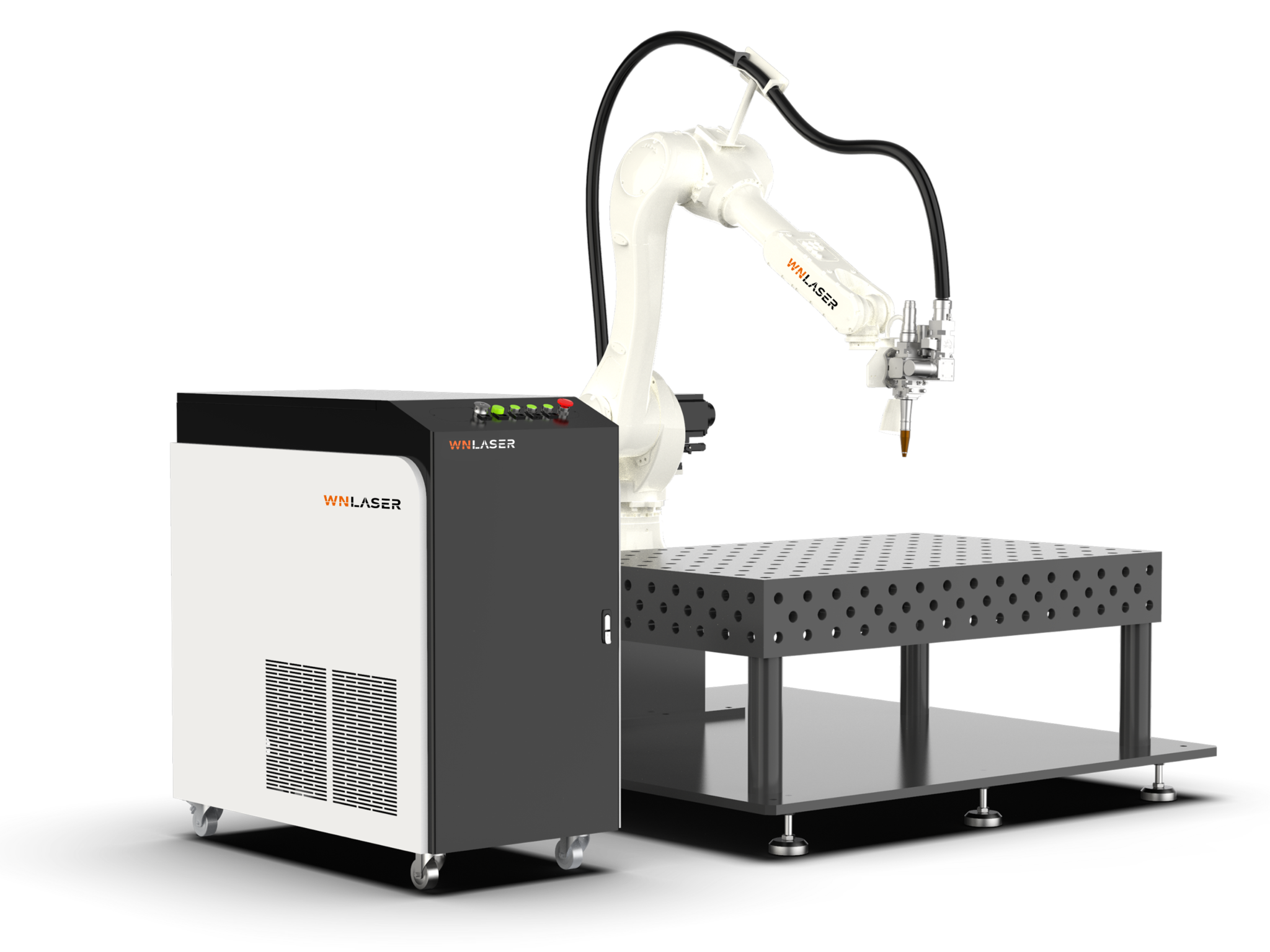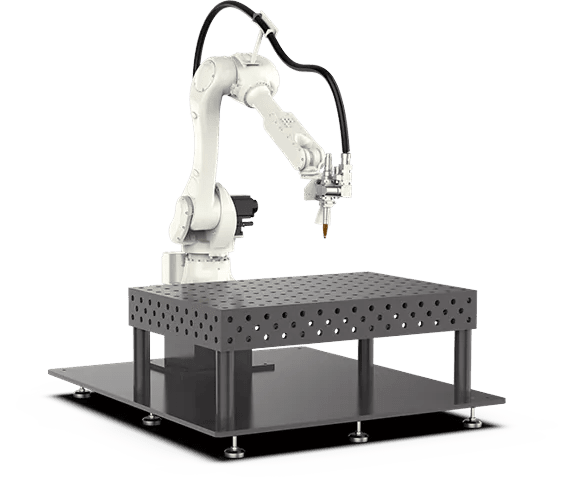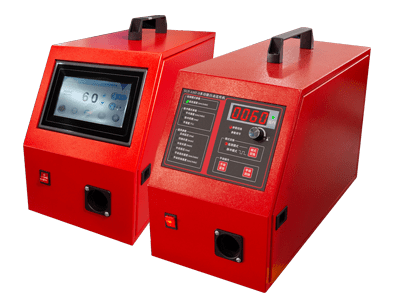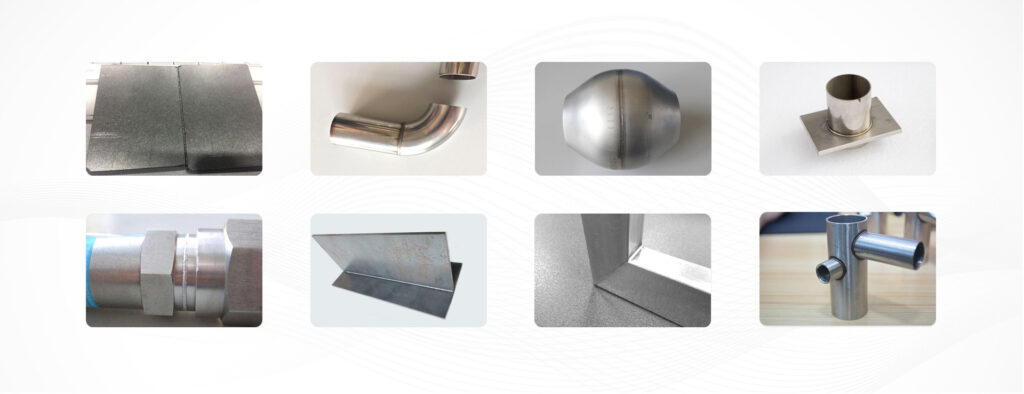WNLASER LASER WELDING MACHINE
HIGH SPEED, HIGH ACCURACY, HIGH EFFICIENCY

Six-axis Robotic Arm Fiber Laser Welding Machine
5.0
Model: WN-W
Power Range: 1000W- 2000W
Features:The robot is sensitive and accurate in response, and effectively cooperates with the laser. After transmission through the optical fiber, the effect of each welding spot is more consistent, and the welding focus position is ensured. So that the quality of the welding seam is significantly improved. The power can be extended to 12000w, which can meet the requirements of thick plate welding and online flying welding.
Product Parameters
| Laser power | 1000W | 1500W | 2000W |
| Total power | 13.3KW | 15.1KW | 19KW |
| Machine weight | 650kg | 700kg | 700kg |
| Welding penetration | 5mm | 6mm | 7mm |
| Machine dimension | 880x1100x750mm | 880x1100x750mm | 1000x1250x750mm |
| Laser type | Fiber laser | ||
| Wavelength | 1064nm | ||
| Cooling method | Water cooling | ||
| Repositioning accurary | ±0.04mm | ||
| Welding mode | Dot/Circle/Line/8 mode | ||
| Spot diameter | 0.1-6mm | ||
Features
Good Sealing
Each axis of the robotic welding machine is completely sealed, suitable for dust, oil, harmful
gas liquid and other high sealing requirements of the harsh environment.




High Precision
This robotic welding machine uses high-quality,
high-performance harmonic reducer,
so that in the running of repeated positioning, to ensure accuracy.
Improved Safety Measures
Multi-function protection, to prevent the robotic arm welding machine in the course of the use of overload,
over temperature, overvoltage situation.

Wire Feeder is Optional
Dual-driven wire feeder
WNLASER offer a wire feeder as standard part for every client,help them get higher welding quality.
Welding Samples

Product Superiority
Large Scale Of The Company
- WNLASER is established in July 2012
- Owns more than 600 square meters of customization.
- More than 30000 square meters factory.
Quality Assurance
- Designers with 20 years of experience,
product quality assurance, provide customer customization. - Professional technical after-sales team,
24-hour online service ,door-to- door service worldwide.
Multinational Recognitione
- All machines passed CE FDA certificate
- Cooperation with clients from USA, Canada, Australia, Europe, South east Asia, Africa etc, more than 100 countries and area.
FAQs for Laser Welding Machine
Laser welding is a process that uses a focused high-energy laser beam to fuse two or more materials together. The materials that can be laser welded depend on several factors, including the properties of the material itself and the type of laser used. In general, laser welding is most effective for materials with high melting points and good thermal conductivity. Some commonly used materials for laser welding include:
- Metal: Laser welding is widely used in the welding of various metals, including aluminum, titanium, stainless steel, copper, brass, gold, silver, platinum, etc.
- Plastics: Certain types of plastics can also be laser welded, such as polycarbonate, acrylic, and ABS. This technique is commonly used in the electronics industry to join plastic parts.
- Ceramics: Laser welding can be used to join ceramic materials such as alumina, zirconia, and silicon carbide. This technique is commonly used in the dental industry to create ceramic dental restorations.
- Glass: Certain rational glasses can also be welded using lasers, such as borosilicate and quartz glass. This method is often used in the production of optical components.
- Composite Materials: Laser welding can be used to join composite materials such as carbon fiber-reinforced plastic (CFRP) and glass fiber-reinforced plastic (GFRP).
It should be noted that not all materials are suitable for laser welding, and the welding process will also affect the characteristics of the materials being joined. Therefore, it is important to consult a qualified welding professional to determine whether laser welding is suitable for a particular application.
The welding capability of our handheld laser welder machine varies based on the power output. For the fiber laser welding machine handheld, the thickness it can weld is as follows:
1000w models: Can weld up to 3mm in carbon steel and stainless steel, and 1mm in aluminum.
1500w models: Capable of welding up to 4mm in carbon steel and stainless steel, and 2mm in aluminum.
2000w models: Suitable for welding up to 5mm in carbon steel and stainless steel, and 3mm in aluminum.
3000w models: These robust models can handle up to 8mm in carbon steel and stainless steel, and 6mm in aluminum.
For 3000w Double-sided welding: It excels at welding thicknesses up to 15mm in carbon steel and stainless steel, and up to 10mm in aluminum.
Our handheld laser welder machine meet a variety of industrial needs, offering metalworking versatility.
Yes, laser welding often requires the use of shielding gas to protect the welding area from atmospheric contamination and oxidation. The type of gas used depends mainly on the material being welded and the laser welding process. In some cases, the laser beam itself can be used to create a vacuum or an inert atmosphere around the weld, eliminating the need for additional shielding gas.
The most commonly used gas in laser welding is argon, which is often used as a shielding gas to protect the weld from oxidation and other atmospheric contamination. Argon is an inert gas that does not react with most materials, making it ideal for welding. In some cases, other gases such as helium, nitrogen, or carbon dioxide can be used in addition to or instead of argon, depending on the materials being welded and the specific welding parameters.
In addition to the shielding gas, laser welding may require a purge gas to remove human contamination or debris from the welding area before the welding process begins. This is especially important when welding some oxidation-sensitive materials such as titanium.
Laser welding is generally considered a safe process when proper safety measures are employed. However, as with any industrial process, there are potential hazards that should be considered and precautions are taken to ensure safety.
One of the main hazards associated with laser welding is exposure to the laser beam itself. The laser beam can cause serious damage to the eyes or skin if proper protective equipment is not used. All personnel near the welding process must wear laser safety glasses or goggles, and the work area must be properly enclosed to prevent accidental exposure to the laser beam.
Another potential hazard is the fumes and gases produced during welding. These fumes and gases can be harmful if inhaled, so proper ventilation is essential. Operators should also wear a respirator or other appropriate respiratory protection, depending on the material being welded.
It is also important to ensure that the laser welding machine is properly maintained and used correctly to prevent accidents. This includes ensuring that the equipment is installed and operated according to the manufacturer’s instructions and that all safety features are in place and functioning properly.
Laser welding can be considered a safe process if proper safety precautions are taken. Employers and workers should follow all relevant safety guidelines and regulations to ensure that the process is carried out safely.
Laser welding machines are used in a variety of applications across industries because of their precision, speed, and ability to work with a variety of materials. Here are some common applications for laser welding machines:
- Automobile Industry: It is widely used in welding door frames, roof panels, bodywork, scheduling systems, and other components.
- Aerospace Industry: It is used in the aerospace industry to weld components such as fuel tanks, engine parts, and hydraulic lines.
- Medical Industry: It is used in the medical industry for the welding of medical devices and instruments, and can weld pacemakers, stents, and surgical instruments.
- Electronic Industry: It is used in the electronic industry for soldering small components and electronic equipment. The precision and control offered by laser welding make it an ideal tool for soldering delicate electronic components.
- Tool And Mold Industry: It is used in the tool and mold industry for welding and repairing molds, and other tool parts.
- Energy Industry: It is used in the energy industry for welding and repairing components such as pipes, valves, and turbines.
- Manufacturing: Laser welding machines are widely used in the manufacturing industry to weld various metal parts. They are especially suitable for welding thin and delicate materials.
Get Custom Quote Now !

